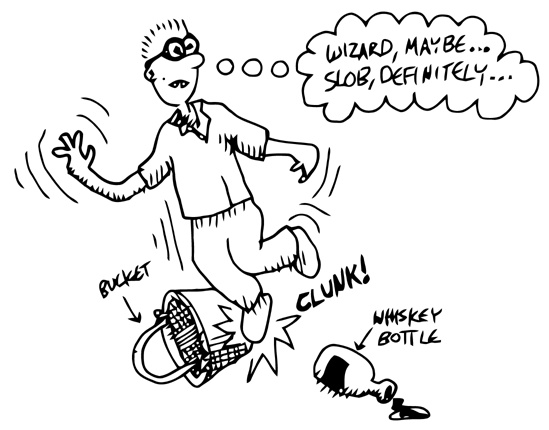To create the final piece of code to help us visualize our game world, we need to describe the objects on the floor at a given location, which a player can pick up and use.
To do so, we first create a list of the objects:
> (defparameter *objects* '(whiskey bucket frog chain))
*OBJECTS*We can also create a second variable, *object-locations*, to track the location of each object in the form of an alist:
(defparameter *object-locations* '((whiskey living-room)
(bucket living-room)
(chain garden)
(frog garden)))Next, we write a function that lists the objects visible from a given location:
(defun objects-at (loc objs obj-locs)(labels ((at-loc-p (obj)
(eq (cadr (assoc obj obj-locs)) loc)))
(remove-if-not #'at-loc-p objs)))
This objects-at function declares a new function named at-loc-p using the labels command ![]() . (Remember that the
. (Remember that the labels function allows you to define functions locally.) Since the at-loc-p function won’t be used elsewhere, we can just declare it directly within objects-at, hiding it from the rest of the code in our program.
The at-loc-p function takes the symbol for an object and returns t or nil, depending on whether that object exists at the location loc. It does this by looking up the object in the obj-locs alist. Then, it uses eq to see whether the location it finds matches the location in question ![]() .
.
Why did we name this function at-loc-p? When a function returns nil or a truth value, it’s a Common Lisp convention to append a p to the end of that function’s name. For instance, you can check that the number 5 is odd by calling (oddp 5). Such true/false functions are called predicates, which is why we use the letter p.
The remove-if-not function in the last line of the listing ![]() , as you might expect, removes all things from a list for which a passed-in function (in this case,
, as you might expect, removes all things from a list for which a passed-in function (in this case, at-loc-p) doesn’t return true. Essentially, it returns a filtered list of objects consisting of those items for which at-loc-p is true.
Here’s what object-at looks like in action:
> (objects-at 'living-room *objects* *object-locations*)
(WHISKEY BUCKET)Now we can write a function to describe the objects visible at a given location:
(defun describe-objects (loc objs obj-loc)(labels ((describe-obj (obj)
`(you see a ,obj on the floor.)))
(apply #'append (mapcar #'describe-obj (objects-at loc objs obj-loc)))))
In this listing, describe-objects first creates the describe-obj function ![]() . This function generates a pretty sentence stating that a given object is on the floor, using quasiquoting
. This function generates a pretty sentence stating that a given object is on the floor, using quasiquoting ![]() . The main part of the function consists of calling
. The main part of the function consists of calling objects-at to find the objects at the current location, mapping describe-obj across this list of objects, and finally appending the descriptions into a single list ![]() .
.
Let’s try running describe-objects:
> (describe-objects 'living-room *objects* *object-locations*)
(YOU SEE A WHISKEY ON THE FLOOR. YOU SEE A BUCKET ON THE FLOOR)Perfect!


